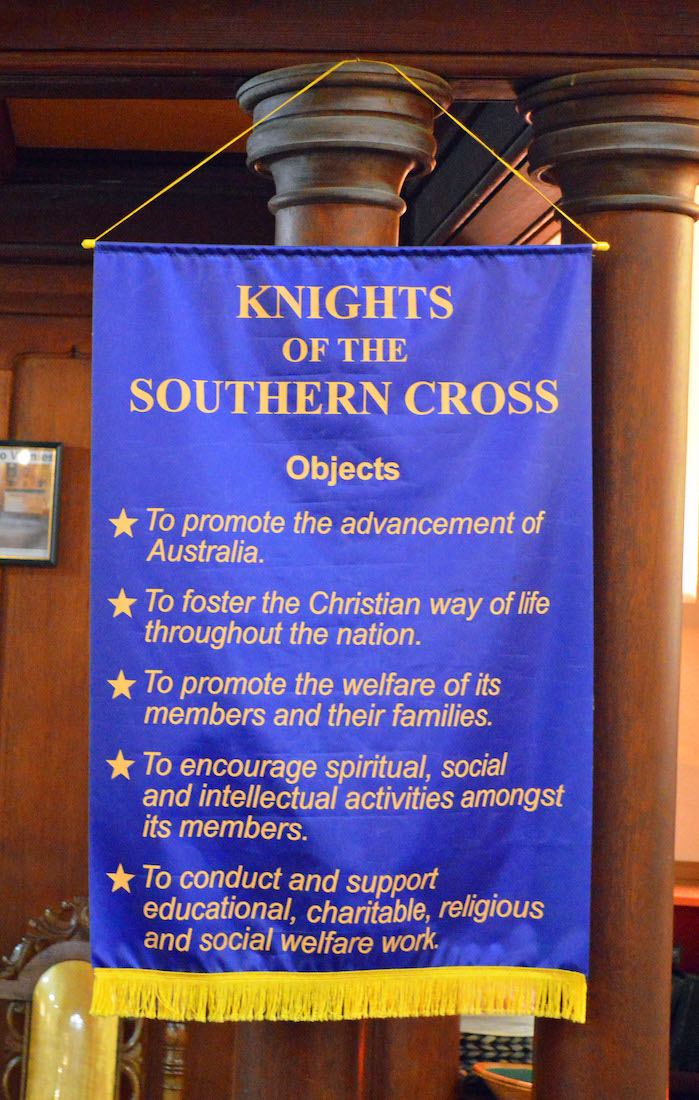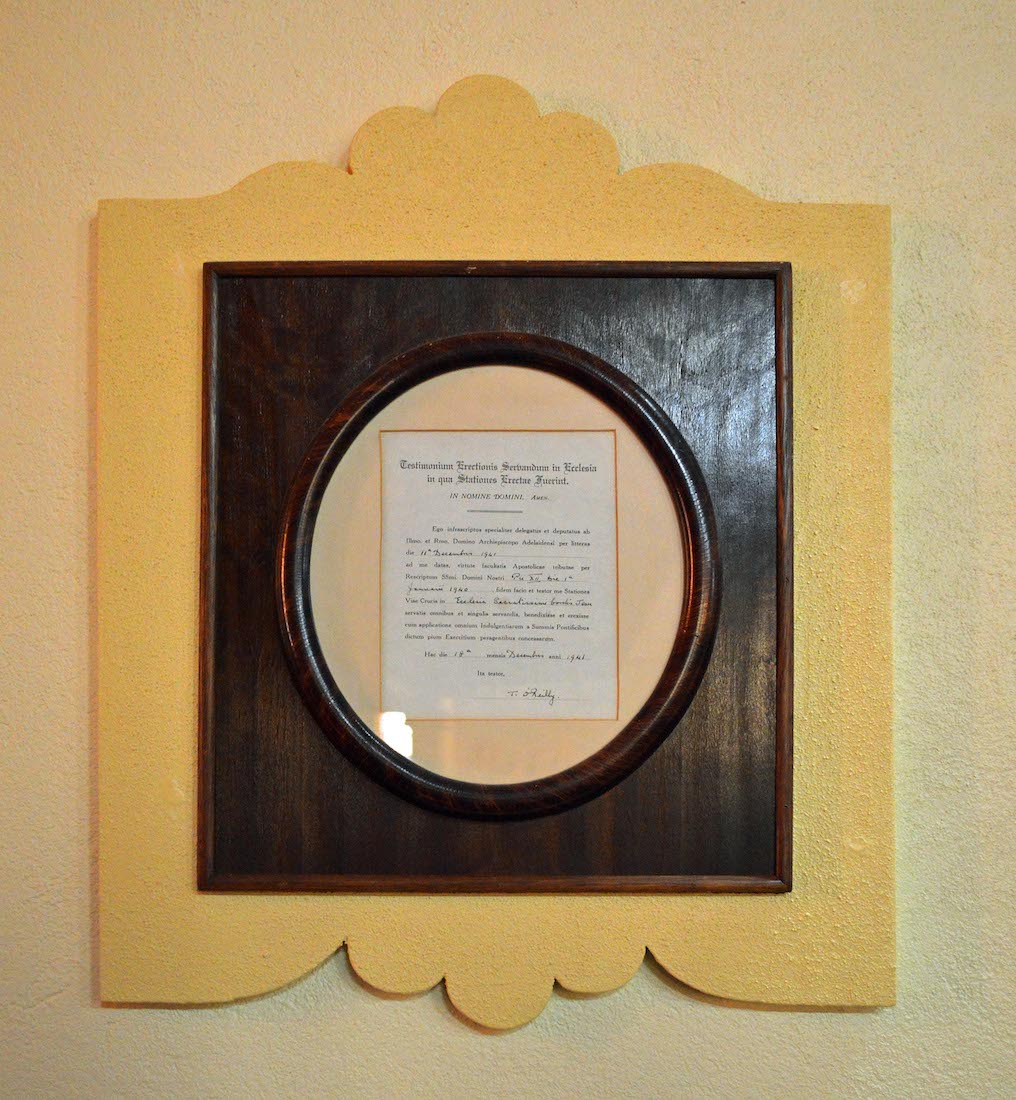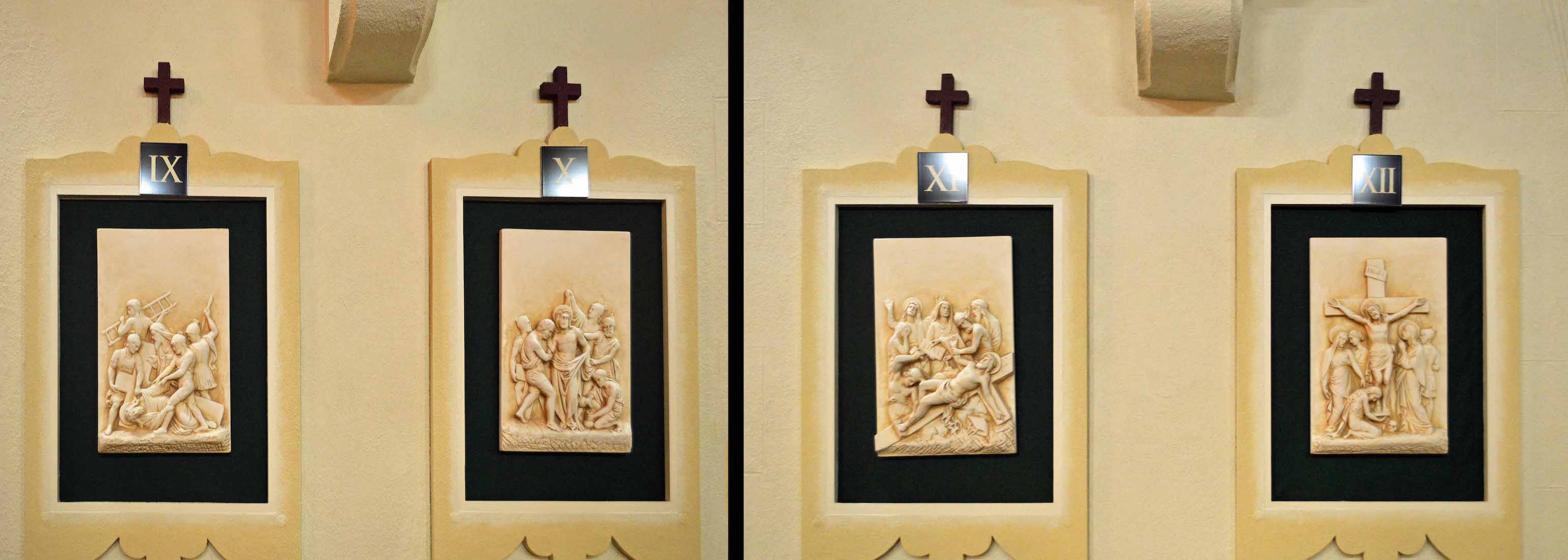
Of particular interest on this table is a wooden model of the Church. Many churches and cathedrals have such models which are useful in giving an overall picture of the building. INDEX
22. WEST WINDOW

Prominent in our view of the West wall are the three lights of the West window. Each light has a wreath and descending foliage. The central light also features a Cross. Within the wreaths, from left, are: • the symbols Alpha and Omega for Christ; • the Sacred Heart; • the letters BV for Blessed Virgin (Mary).
23. KNIGHTS’ BANNER
The Order of the Knights of the Southern Cross is a national organisation of Catholic laymen which strives to serve the wider community and support those in need. The banner lists five key objectives.
24. ST THÉRÈSE
In the back corner of the nave stands a statue of Saint Thérèse of Lisieux, 1873 – 1897. She was a French Catholic Discalced Carmelite nun who is widely venerated in modern times. She is popularly known as ‘The Little Flower of Jesus’, or simply ‘The Little Flower’. Pope Saint Pius X called her ‘the greatest saint of modern times’.
25. FRAMED DOCUMENT
This framed document appears to be a blessing from Pope Pius XII, dated 18th December 1941.
26. WEST NAVE WINDOWS
These two windows are in the nave West wall, on either side of the main entry doors. One is in memory of Annie Treloar and Lionel Frevell; the other remembers John Liddy.
27. NORTH NAVE WALL
We turn now to the nave North wall. There is a central door – presumably to a confessional – above which is a statue of the Sacred Heart. On either side, windows alternate with pairs of Stations of the Cross. There is a painting on the wall at the far end.
28. STATIONS OF THE CROSS
The Stations of the Cross are attractively sculpted from cream marble. As examples, Stations IX – XII are shown here. These depict from left: • Jesus falls for the third time; • Jesus is stripped of his clothes; • Jesus is nailed to the cross; • Jesus dies on the cross.
29. SACRED HEART STATUE
The Sacred Heart devotion is especially concerned with what the Church deems to be the longsuffering love and compassion of the heart of Christ towards humanity. The popularization of this devotion in its modern form is derived from a French Roman Catholic nun, Saint Margaret Mary Alacoque, who said she learned the devotion from Jesus during a series of appearances to her between 1673 and 1675.
30. NAVE WINDOWS
The side nave windows are all alike, with a fleur-de-lis at the top, and a small text panel near the base. The illustrated windows remember from left: • Maisie O’Lauchlan; • William and Mary Spurling; • Dorothy Brady; • Ellen Liddy.
31. LAST SUPPER PAINTING
This print is of a painting called ‘Abendmahl’ (The Last Supper), painted in 1919 by German artist Kaspar Schleibner. Schleibner was born in 1863 in Hallstadt , and died in 1931 in Munich. He was a painter of Christian art. The painting was given in memory of John Liddy in 1935.
32. PIETÀ
In the Northeast corner of the nave is a sculpture of the Piétà – Mary holding the body of the crucified Christ. The stone pedestal carries the Chi-Rho symbol for Christ.
33. LECTERN AND PASCHAL CANDLE
Nearby is the lectern from which the Scripture is read, and a Paschal candle, representing Christ as the Light of the world.
35. MADONNA AND CHILD
The painting at left is a print of the Sistine Madonna – an oil painting by the Italian artist Raphael Sanzio. The painting was commissioned in 1512 by Pope Julius II for the church of San Sisto, Piacenza. The canvas was one of the last Madonnas painted by Raphael.
36. CHRIST ON THE CROSS
At right is a large painting of Christ hanging on the Cross. This portrayal is known as a crucifix meaning ‘(one) fixed to a cross’, as distinct from a bare cross. The representation of Jesus himself on the cross is referred to in English as the corpus (Latin for ‘body’). The crucifix is a principal symbol for many groups of Christians,
37. SANCTUARY WINDOWS
The sanctuary windows form a set, with the two at left on the North wall, and the remaining window on the South wall. Each window has a symbol at the top: • Cross and Eucharist elements; • Sun with IHS (Jesus) symbol; • Cross and candle with (Latin) words: Stay with us, O Lord, for the day is almost over, Alleluja.
38. ALTAR
This altar is not really a ‘nave’ altar, but it satisfies the liturgical principle of Vatican II by being separated from the wall behind and having the celebrating priest facing the congregation. It carries a cross and two candles.
39. MADONNA AND CHILD
There is a statue on either side of the altar. At left we see Mary as Queen of Heaven holding the Christ Child. Mary holds a sprig of fleur-de-lis, and Jesus an emblem of the world. The Child gives a sign of blessing.
40. ST JOSEPH AND JESUS
At right, Joseph holds a budding branch and a similar Christ child. The branch has reference to an old legend. I reflect that Joseph is seldom if ever portrayed as holding the ‘baby’ Jesus – some male stereotyping here!



















